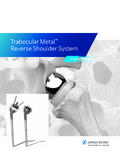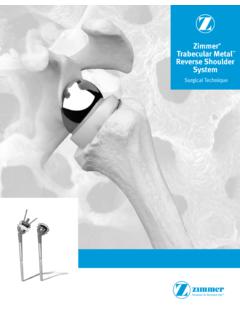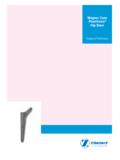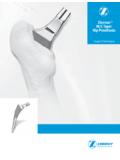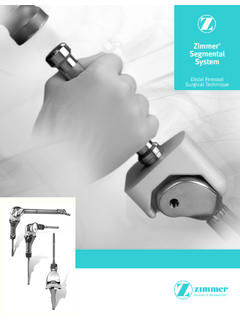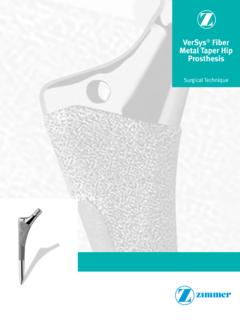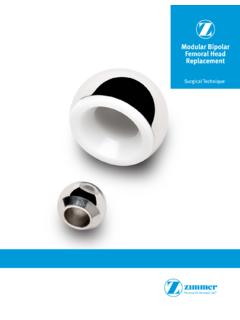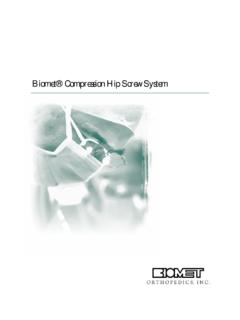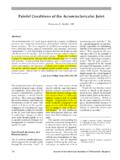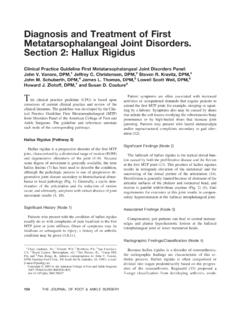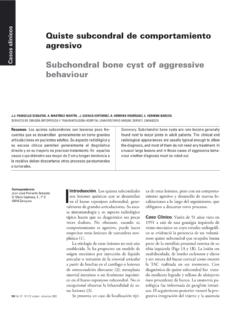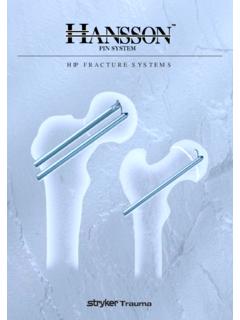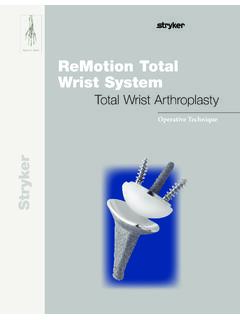Transcription of Converge® CSTi™ Porous Acetabular Cup System …
1 converge CSTi Porous Acetabular Cup SystemSurgical Technique1001-45-035 Rev. 2 14/10/15 1:13 PM2 converge CSTi Porous Acetabular Cup System surgical Technique1001-45-035 Rev. 2 24/10/15 1:13 PM3 converge CSTi Porous Acetabular Cup System surgical TechniqueCONVERGE CSTI Porous Acetabular CUP System CONTENTSINTRODUCTION ..4 PREOPERATIVE PLANNING ..5 Templating the Acetabulum ..5 PRIMARY SURGERY ..6 Joint Exposure ..7 Acetabular Preparation ..11 Trialing ..12 Acetabular Implantation ..14 Polyethylene Insert Placement ..18 REVISION SURGERY ..20 Joint Exposure ..21 Acetabular Preparation ..23 Acetabular Implantation ..28 CLOSURE ..31 Posterior Lateral Approach ..31 Anterior Lateral Approach ..32 SUPPLEMENT: INSERT ALTERNATIVES ..33 Metasul Insert Removal.
2 34 Constrained 36 ORDERING INFORMATION ..441001-45-035 Rev. 2 34/10/15 1:13 PM4 converge CSTi Porous Acetabular Cup System surgical TechniqueIntroductionConverge is a comprehensive Acetabular System designed to accommodate many press-fit primary and revision situations. (see Ordering section, pages 44-46 for compatible instruments and implants)Multiple Tribological Options Durasul Highly Crosslinked Polyethylene Conventional PEComplete Range of Liner and Cup Styles Hemispherical, cluster-hole, rimflare with screwholes, rimflare, multi-hole and protrusio cups Compatible with Epsilon inserts, which include standard, hooded, constrained and protrusio stylesProven Concept for Biological Fixation CSTi Porous coating has over 15 years of clinical experience with demonstrated success in both retrieval and long-term clinical stability and range-of-motion Industry-first Large Diameter Head System offering up to 44mm CoCr heads in combination with Durasul PE Chamfered liner geometr y optimized to maximize ROM1 Udomkiat P, Dorr LD, Wan Z.
3 Cementless hemispherical Porous -coated sockets implanted with press-fit technique without screws: Average ten-year follow-up. JBJS (Am). 2002;84(7) Highly Crosslinked Polyethylene22-, 28-, 32-, 38-, 44mm CoCr HeadsConverge CSTi Porous Acetabular SystemConstrained Insert1001-45-035 Rev. 2 44/10/15 1:13 PM5 converge CSTi Porous Acetabular Cup System surgical TechniqueFig. 1 Preoperative PlanningTemplating the AcetabulumUnlike the femur, the acetabulum is templated using the side to be reconstructed. Estimation of the size of the Acetabular component is the primary objective of templating the acetabulum. Proper size determination helps in selecting the proper reamers and evaluating the coverage of the cup. Large defects present on the operative side must be taken into account.
4 In the majority of cases, an approximate size can be acetabulum is templated on both the A/P and lateral radiographs. The hemisphere of the Acetabular component is aligned with the mouth of the bony acetabulum, avoiding any osteophytes. On the A/P radiograph (Figs. 1 and 2), the component should rest on the cortical floor of the cotyloid notch, and may touch but should rarely violate the teardrop or the ilioischial line (Kohler s line); the component should have a maximum lateral opening of 40 degrees. If protrusio is present, the lateral edge of the teardrop is used. The cup size selected may appear to remove excessive iliac bone on the A/P radiograph, but the lateral film gives a better indication of cup size since the hemispherical subchondral bone can be clearly seen.
5 On the groin lateral radiograph, the cup size selected should contact the anterior and posterior rim of the bony acetabulum and the medial subchondral bone. The center of rotation of the femoral head should be anatomically reproduced by the position of the Acetabular component. If a bony defect is identified, use the correctly placed template to measure for size and determine any need for bone 2 1001-45-035 Rev. 2 54/10/15 1:13 PM6 converge CSTi Porous Acetabular Cup System surgical TechniquePRIMARY SURGERY CONTENTSJOINT EXPOSURE ..7 Posterior Lateral 7 Anterior Lateral Approach (Alternative Approach) ..9 Acetabular PREPARATION ..11 TRIALING ..12 Acetabular IMPLANTATION ..14 Shell Placement for Cluster-Hole and Hemispherical Shells ..14 Shell Placement for Rimflare Shells.
6 15 Optional Screw Placement ..16 POLYETHYLENE INSERT PLACEMENT ..181001-45-035 Rev. 2 64/10/15 1:13 PM7 converge CSTi Porous Acetabular Cup System surgical TechniqueFig. 3 Fig. 4 Joint ExposurePosterior Lateral ApproachThe straight, longitudinal portion of the incision begins four fingerbreadths below the vastus tubercle and continues to one fingerbreadth above the tip of the greater trochanter. It then curves toward the posterior inferior spine, or 60 degrees to the straight line of the incision (Fig. 3).The incision is carried sharply down through subcutaneous tissue, fascia lata and the fascia of the gluteus maximus muscle. This muscle is gently split in line with its fibers. A self-retaining Charnley retractor is retract the gluteus medius superiorly and reveal the piriformis tendon, either a 9/64-inch Steinmann pin or a small bent Hohman retractor should be placed under the gluteus medius and on top of the gluteus minimus.
7 The femoral insertion of the gluteus maximus tendon is transected one centimeter from its insertion to permit easy retraction of the femur anteriorly and to allow complete visualization of the acetabulum. If desired, a leg length measurement can be taken at this time. With the hip in 30 degrees of flexion, neutral rotation and neutral abduction/adduction, the distance is measured between the superior pin and a drill hole placed in the greater knee is flexed, and the leg is internally rotated. Using a hot knife, the piriformis, short external rotators, quadratus femoris and posterior capsule are incised off the posterior trochanter as a continuous sleeve to expose the lesser trochanter (Fig. 4). The hip is dislocated. A bone hook or skid may be used to avoid excess torsion on the femoral Rev.
8 2 74/10/15 1:13 PM8 converge CSTi Porous Acetabular Cup System surgical TechniqueFig. 5 Fig. 6A Hohmann retractor is placed distally to the capsule into the obturator foramen. The medial capsule is incised to the posterior insertion of the transverse Acetabular ligament. Hohman retractors are placed under the lesser trochanter and femoral head for exposure of the head and neck. This permits adequate visualization for proper transection of the femoral neck (Fig. 5).NOTE: If bone slurry is to be placed into the acetabulum, the posterior portion of the head is decapitated and graft obtained with the smallest Acetabular reamer prior to the the femoral neck at the templated level, then retract the femur anteriorly to expose the acetabulum. Move the distal Hohman retractor to a position under the neck during transection to protect the sciatic curved snake retractor is placed on the pelvis at the superior-anterior corner of the acetabulum (10 o clock for left hip, 2 o clock for right hip) to hold the femur anterior to the acetabulum (Fig.)
9 6). For retraction of the capsule posteriorly, either a posterior acetabulum retractor or two 9/64-inch Steinmann pins driven into the ischium and posterior column may be used. These are inserted inside the capsule but outside the labrum, thus using the capsule to retract the sciatic nerve out of harm s way. A Hohman retractor is positioned under the transverse Acetabular ligament. The labrum and osteophytes are removed for exposure of the acetabulum. The entire acetabulum should now be in full view. It may be necessary to cauterize the Acetabular branch of the obturator artery as reaming begins, since it enters the acetabulum under the transverse ligament at its ischial Rev. 2 84/10/15 1:13 PM9 converge CSTi Porous Acetabular Cup System surgical TechniqueFig.
10 7 Fig. 8 Anterior Lateral Approach (Alternate Approach)With the hip flexed about 30 degrees, a straight incision of approximately 25cm in length is made, centered over the middle of the greater trochanter. It should extend at least 10cm proximal to the tip of the greater trochanter (Fig. 7).The gluteus maximus muscle is divided in the direction of its fibers. After the gluteus maximus and tensor fascia are carefully dissected from the gluteus medius fascia, a Charnley self-retaining retractor is leg is positioned into neutral rotation. Using cautery, an incision is made through the mid-vastus lateralis fascia, crossing the mid-greater trochanter, then following the direction of the fibers, the gluteus medius is divided in half (Fig. 8).The gluteus medius is divided no more than 3cm proximally, so as not to potentially denervate the anterior half.
